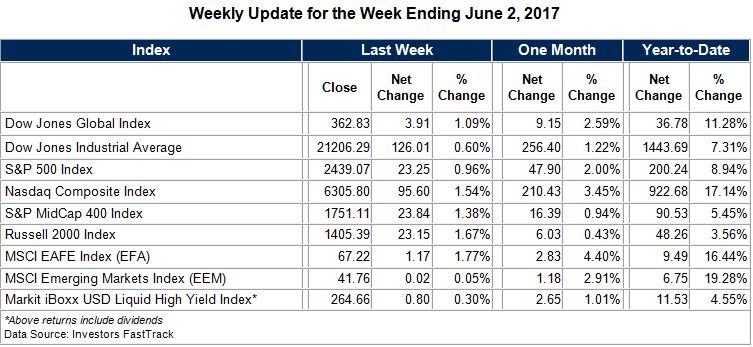Here's To Your Wealth
May 2017
|
|
The Markets:
In A Tale of Two Cities, Charles Dickens famously writes "it was the best of times, it was the worst of times." Today, depending on where you get your news, you might agree with either perspective. While some channels and websites report chaos, collusion, corruption, and ineptitude, others report a picture of leadership, reopened factories, promises kept, and American strength rebuilt. Wherever the truth resides, Wall Street seems to have come to its own conclusions and many stock-market investors believe we are seeing the best of times.
Several U.S. stock-market indices are flirting with all-time highs. In fact, multiple stock markets around the world, notably in developed Europe and emerging markets, are outperforming the high-flying U.S. market thus far in 2017. For many casual market observers, this global stock rally may seem surprising. But for investors who are focusing on the news rather than the catchy headlines, there is a story of economic strength inside the numbers. I will agree that it's hard to identify substantive news these days; but if you do, you might hear about what is really going on in areas that actually matter, at least from an investor's perspective.
Our domestic economy continues to move forward albeit at a modest rate. The consumer remains strong and is finally benefitting from some wage growth. We also see low levels of personal debt, low unemployment, low oil prices, and surprisingly low interest rates. All of these factors are typically bullish for the overall U.S. stock market. European growth rates are finally perking up, and perhaps most importantly, corporate earnings around the globe are strengthening. When we look at this economic news, it is easier to see why the stock market continues to climb, and why a sudden and dramatic end to this historic bull market is unlikely.
As with any market, you'll see warning signs; but I am fairly sure these substantive cautionary notes are not what is blaring on the evening news headlines. One indicator of concern is the recent decline in U.S. interest rates. Last summer,
the 10-year U.S. Treasury Note
fell to around the 1.40% range. Gradually, as the economy showed some improvement, rates climbed to about 1.80% a week before Election Day in November. Subsequently, with Wall Street's exuberance regarding the "Trump Agenda," the 10-year Note soared to 2.60%, signaling the bond market's expectation of a more rapidly growing economy. However, in the past few months we have seen the 10-year Note slump to 2.20%. This rapid drop may be signaling that the bond market is no longer expecting robust growth.
Given that the economic data is strong, it seems the bond market's reaction may be due more to the lack of legislative movement and the dimming hopes for comprehensive tax reform passing a divided Republican party and a Democrat party staunchly in opposition. With an infrastructure spending bill also seeming less likely, the bond market may be telling us that the President's full tax and infrastructure plan's passing Congress is unlikely.
Why listen to the bond market? To many seasoned Wall Street pros, the bond market is considered the "smart money." And this is for good reason. Perhaps surprisingly, the bond market is actually bigger than the stock market. Many long-term investors (such as pension funds, insurance companies, and retirees) have their financial futures tied to the bond market.
Looking back in time, we don't see the type of crashes associated with bond markets that we see with stocks. Bonds tend to trade more in line with actual realities, and while they will also correct and decline from time to time, they tend to be a good forecaster of economic activity. With the 10-year Treasury Note smack in the middle of its post-election trading range, the bond market may be looking at the uncertainty in Washington and contemplating which cable channel has the real news and which has the fake news.
|
 |
When I listen to the radio, I just hear so much music that doesn't even sound like people. The vocals are all tuned and the drums are all fake. ~Dave Grohl, Lead Singer Foo Fighters
Mark Avallone and the Potomac Wealth Advisors Team
P.S. Please feel free to forward this commentary to family, friends, or colleagues. If you would like us to add them to the list, please reply to this e-mail with their e-mail address and we will ask for their permission to be added.
Potomac Wealth Advisors, LLC
15245 Shady Grove Road, Suite 410
Rockville, MD 20850
Phone: 301-279-2221
Securities and Investment Advisory Services offered through H. Beck, Inc., Member FINRA/SIPC. 6600 Rockledge Drive, 6th Floor, Bethesda, MD 20817 301.468.0100. Potomac Wealth Advisors, LLC is not affiliated with H. Beck, Inc.
This material represents an assessment of the market environment at a specific point in time and is not intended to be a forecast of future events, or a guarantee of future results. This information should not be relied upon by the reader as research or investment advice regarding any funds or stocks in particular, nor should it be construed as a recommendation to purchase or sell a security. Past performance is no guarantee of future results. Investments will fluctuate and when redeemed may be worth more or less than when originally invested.
Diversification and asset allocation do not guarantee against loss. They are methods used to manage risk.
This report has been derived from information considered reliable, but it cannot be guaranteed as to accuracy or completeness.
This report has been derived from information considered reliable, but it cannot be guaranteed as to accuracy or completeness.
|
|
|
The indexes are constructed and weighted using market value-weighted index. They provide 95 percent market capitalization coverage of developed markets and emerging markets. More than 3000 DJGI indexes provide data on more than 5500 companies around the world. Market capitalization is float-adjusted *The DJIA is a widely followed measurement of the stock market. The average is comprised of 30 stocks that represent leading companies in major industries. * The Standard & Poor's 500 (S&P 500) is an unmanaged group of securities considered to be representative of the stock market in general. *The NASDAQ Composite Index is a market-valued weighted index, which measures all securities listed on the NASDAQ stock market. *The S&P Mid Cap 400 Index This Standard & Poor's index serves as a barometer for the U.S. mid-cap equities sector and is the most widely followed mid-cap index in existence. To be included in the index, a stock must have a total market capitalization that ranges from roughly $750 million to $3 billion dollars. Stocks in this index represent household names from all major industries including energy, technology, healthcare, financial and manufacturing.
*The
Russell 2000 Index is a small-cap
stock market index of the bottom 2,000 stocks in the
.
* The
MSCI EAFE Index is a
stock market index that is designed to measure the equity market performance of
developed markets outside of the U.S. & Canada. It is maintained by
MSCI Barra,
[1]a provider of investment decision support tools; the EAFE acronym stands for
Europe, Australasia and Far East.
* The MSCI
Emerging Markets Indexs a float-adjusted market capitalization index that consists of indices in 21 emerging economies: Brazil, Chile, China, Colombia, Czech Republic, Egypt, Hungary, India, Indonesia, Korea, Malaysia, Mexico, Morocco, Peru, Philippines, Poland, Russia, South Africa, Taiwan, Thailand, and Turkey.
* Opinions expressed are subject to change without notice and are not intended as investment advice or to predict future performance.
*The economic forecasts set forth in the presentation may not develop as predicted and there can be no guarantee that strategies promoted will be successful.
* Consult your financial professional before making any investment decision.
* To unsubscribe from the "Potomac Wealth Advisors, LLC newsletters" please reply to this email [email protected] with "Unsubscribe" in the subject line, or click below Safeunsubscribe. You may also write us at "15245 Shady Grove Road, Suite 410, Rockville, MD, 20850
|
|
|
Learn more about Mark Avallone's recently released book, Countdown To Financial Freedom
 Recognized by:
The Washington Post
as a Greater Washington DC Region Five Star Wealth Manager (2015)
The Financial Times
as one of the country's Top 401 Retirement Plan Advisor (2015)
Private Wealth Magazine
as a member of their Inaugural All-Star Research Team (2012)
Washington Business Journal
as one of Washington's Premier Wealth Advisors (2011, 2012, 2013, 2014)
NABCAP
as one of the Top Wealth Managers in the Washington, DC Metropolitan Region (2011, 2012, 2013, 2014)
SmartCEO Magazine
Magazine Money Manager Award Recipient Finalist, Washington, D.C. Metropolitan Region
(2015)
Consumers' Research Council of America
as one of America's Top Financial Planners (2011, 2012, 2013, 2014)
DC Magazine
as a Five Star Wealth Manager, Washington, D.C. Metropolitan Region (2012)
SmartCEO Magazine
Magazine Top Wealth Manager, Washington, D.C. Metropolitan Region
(2012)
Financial Advisor Magazine
as an All-Star Research Manager (2012)
|
 |
|
|